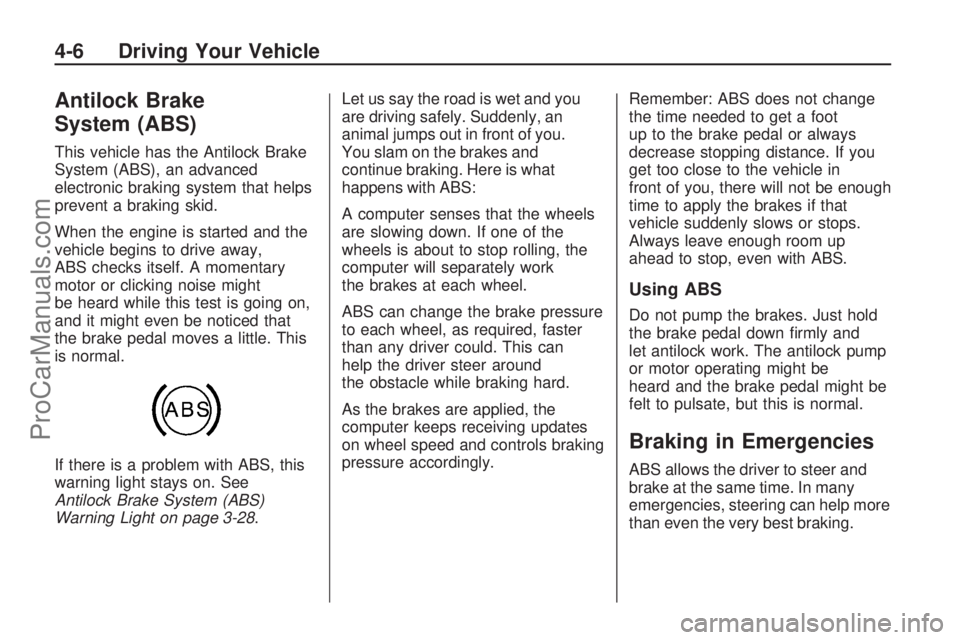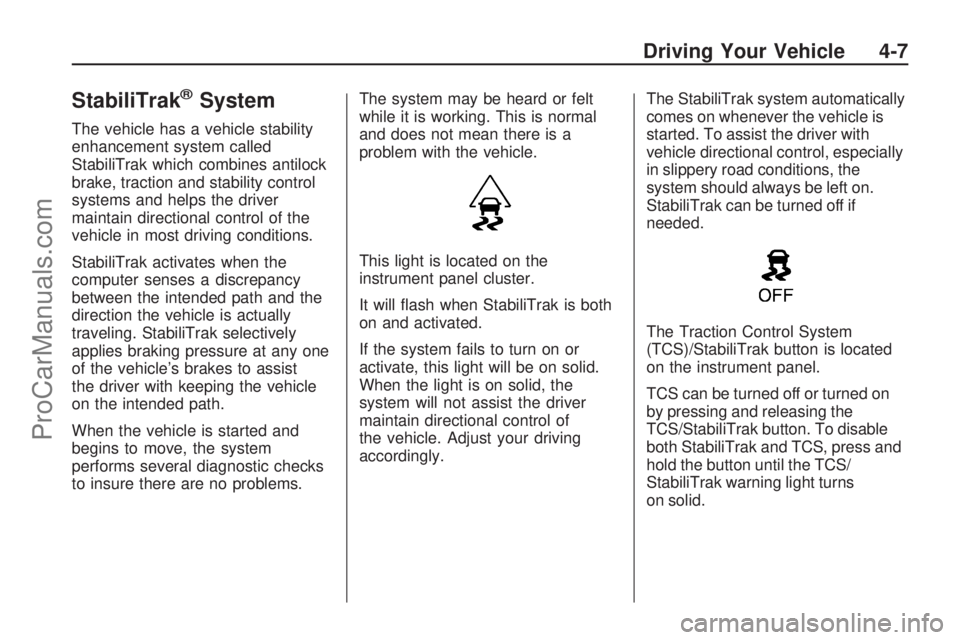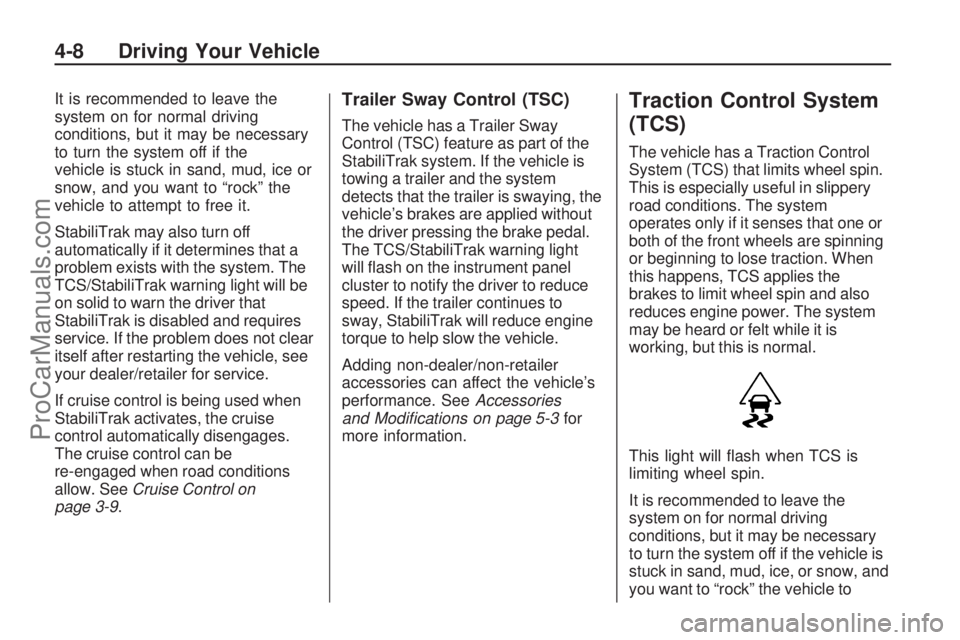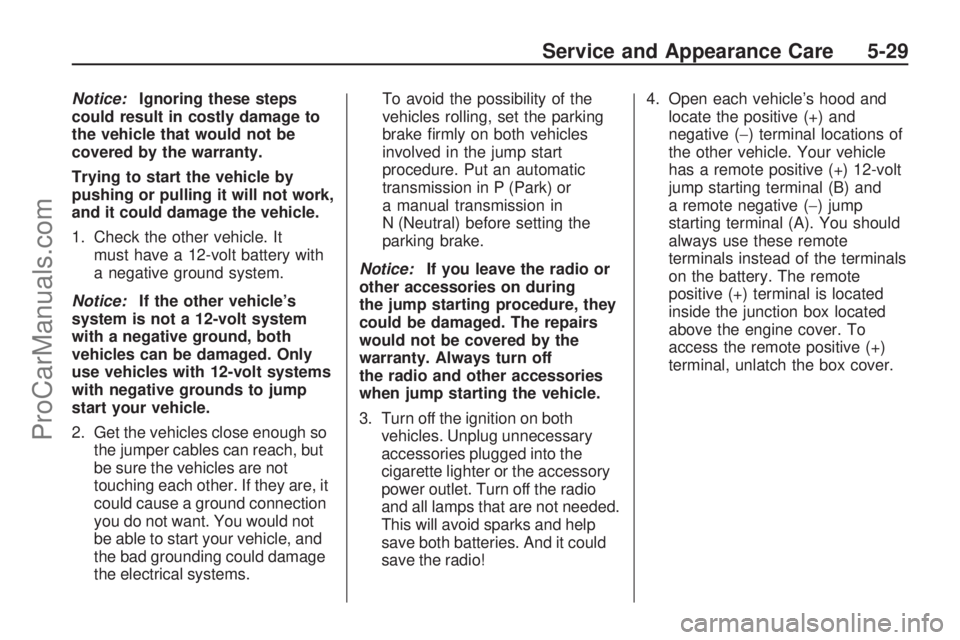brake light SATURN VUE HYBRID 2009 User Guide
[x] Cancel search | Manufacturer: SATURN, Model Year: 2009, Model line: VUE HYBRID, Model: SATURN VUE HYBRID 2009Pages: 346, PDF Size: 2.1 MB
Page 191 of 346

Braking
SeeBrake System Warning Light on
page 3-27.
Braking action involves perception
time and reaction time. Deciding
to push the brake pedal is
perception time. Actually doing it is
reaction time.
Average reaction time is about
three-fourths of a second. But that
is only an average. It might be
less with one driver and as long as
two or three seconds or more
with another. Age, physical
condition, alertness, coordination,
and eyesight all play a part. So
do alcohol, drugs, and frustration.
But even in three-fourths of a
second, a vehicle moving at 60 mph
(100 km/h) travels 66 feet (20 m).
That could be a lot of distance in an
emergency, so keeping enough
space between the vehicle
and others is important.And, of course, actual stopping
distances vary greatly with the
surface of the road, whether it is
pavement or gravel; the condition of
the road, whether it is wet, dry, or
icy; tire tread; the condition of
the brakes; the weight of the vehicle;
and the amount of brake force
applied.
Avoid needless heavy braking. Some
people drive in spurts — heavy
acceleration followed by heavy
braking — rather than keeping pace
with traffic. This is a mistake. The
brakes might not have time to cool
between hard stops. The brakes will
wear out much faster with a lot of
heavy braking. Keeping pace with
the traffic and allowing realistic
following distances eliminates a lot of
unnecessary braking. That means
better braking and longer brake life.If the engine ever stops while the
vehicle is being driven, brake
normally but do not pump the
brakes. If the brakes are pumped,
the pedal could get harder to
push down. If the engine stops,
there will still be some power brake
assist but it will be used when
the brake is applied. Once the power
assist is used up, it can take
longer to stop and the brake pedal
will be harder to push.
Adding non-dealer/non-retailer
accessories can affect vehicle
performance. SeeAccessories and
Modifications on page 5-3.
Driving Your Vehicle 4-5
ProCarManuals.com
Page 192 of 346

Antilock Brake
System (ABS)
This vehicle has the Antilock Brake
System (ABS), an advanced
electronic braking system that helps
prevent a braking skid.
When the engine is started and the
vehicle begins to drive away,
ABS checks itself. A momentary
motor or clicking noise might
be heard while this test is going on,
and it might even be noticed that
the brake pedal moves a little. This
is normal.
If there is a problem with ABS, this
warning light stays on. See
Antilock Brake System (ABS)
Warning Light on page 3-28.Let us say the road is wet and you
are driving safely. Suddenly, an
animal jumps out in front of you.
You slam on the brakes and
continue braking. Here is what
happens with ABS:
A computer senses that the wheels
are slowing down. If one of the
wheels is about to stop rolling, the
computer will separately work
the brakes at each wheel.
ABS can change the brake pressure
to each wheel, as required, faster
than any driver could. This can
help the driver steer around
the obstacle while braking hard.
As the brakes are applied, the
computer keeps receiving updates
on wheel speed and controls braking
pressure accordingly.Remember: ABS does not change
the time needed to get a foot
up to the brake pedal or always
decrease stopping distance. If you
get too close to the vehicle in
front of you, there will not be enough
time to apply the brakes if that
vehicle suddenly slows or stops.
Always leave enough room up
ahead to stop, even with ABS.
Using ABS
Do not pump the brakes. Just hold
the brake pedal down �rmly and
let antilock work. The antilock pump
or motor operating might be
heard and the brake pedal might be
felt to pulsate, but this is normal.
Braking in Emergencies
ABS allows the driver to steer and
brake at the same time. In many
emergencies, steering can help more
than even the very best braking.
4-6 Driving Your Vehicle
ProCarManuals.com
Page 193 of 346

StabiliTrak®System
The vehicle has a vehicle stability
enhancement system called
StabiliTrak which combines antilock
brake, traction and stability control
systems and helps the driver
maintain directional control of the
vehicle in most driving conditions.
StabiliTrak activates when the
computer senses a discrepancy
between the intended path and the
direction the vehicle is actually
traveling. StabiliTrak selectively
applies braking pressure at any one
of the vehicle’s brakes to assist
the driver with keeping the vehicle
on the intended path.
When the vehicle is started and
begins to move, the system
performs several diagnostic checks
to insure there are no problems.The system may be heard or felt
while it is working. This is normal
and does not mean there is a
problem with the vehicle.
This light is located on the
instrument panel cluster.
It will �ash when StabiliTrak is both
on and activated.
If the system fails to turn on or
activate, this light will be on solid.
When the light is on solid, the
system will not assist the driver
maintain directional control of
the vehicle. Adjust your driving
accordingly.The StabiliTrak system automatically
comes on whenever the vehicle is
started. To assist the driver with
vehicle directional control, especially
in slippery road conditions, the
system should always be left on.
StabiliTrak can be turned off if
needed.
The Traction Control System
(TCS)/StabiliTrak button is located
on the instrument panel.
TCS can be turned off or turned on
by pressing and releasing the
TCS/StabiliTrak button. To disable
both StabiliTrak and TCS, press and
hold the button until the TCS/
StabiliTrak warning light turns
on solid.
Driving Your Vehicle 4-7
ProCarManuals.com
Page 194 of 346

It is recommended to leave the
system on for normal driving
conditions, but it may be necessary
to turn the system off if the
vehicle is stuck in sand, mud, ice or
snow, and you want to “rock” the
vehicle to attempt to free it.
StabiliTrak may also turn off
automatically if it determines that a
problem exists with the system. The
TCS/StabiliTrak warning light will be
on solid to warn the driver that
StabiliTrak is disabled and requires
service. If the problem does not clear
itself after restarting the vehicle, see
your dealer/retailer for service.
If cruise control is being used when
StabiliTrak activates, the cruise
control automatically disengages.
The cruise control can be
re-engaged when road conditions
allow. SeeCruise Control on
page 3-9.Trailer Sway Control (TSC)
The vehicle has a Trailer Sway
Control (TSC) feature as part of the
StabiliTrak system. If the vehicle is
towing a trailer and the system
detects that the trailer is swaying, the
vehicle’s brakes are applied without
the driver pressing the brake pedal.
The TCS/StabiliTrak warning light
will �ash on the instrument panel
cluster to notify the driver to reduce
speed. If the trailer continues to
sway, StabiliTrak will reduce engine
torque to help slow the vehicle.
Adding non-dealer/non-retailer
accessories can affect the vehicle’s
performance. SeeAccessories
and Modifications on page 5-3for
more information.
Traction Control System
(TCS)
The vehicle has a Traction Control
System (TCS) that limits wheel spin.
This is especially useful in slippery
road conditions. The system
operates only if it senses that one or
both of the front wheels are spinning
or beginning to lose traction. When
this happens, TCS applies the
brakes to limit wheel spin and also
reduces engine power. The system
may be heard or felt while it is
working, but this is normal.
This light will �ash when TCS is
limiting wheel spin.
It is recommended to leave the
system on for normal driving
conditions, but it may be necessary
to turn the system off if the vehicle is
stuck in sand, mud, ice, or snow, and
you want to “rock” the vehicle to
4-8 Driving Your Vehicle
ProCarManuals.com
Page 196 of 346

Try to adjust the speed so you can
drive through the curve. Maintain
a reasonable, steady speed. Wait to
accelerate until out of the curve,
and then accelerate gently into the
straightaway.
Steering in Emergencies
There are times when steering can
be more effective than braking. For
example, you come over a hill and
�nd a truck stopped in your lane, or a
car suddenly pulls out from nowhere,
or a child darts out from between
parked cars and stops right in front of
you. These problems can be avoided
by braking — if you can stop in time.
But sometimes you cannot stop in
time because there is no room.
That is the time for evasive
action — steering around the
problem.
The vehicle can perform very well
in emergencies like these. First apply
the brakes. SeeBraking on
page 4-5. It is better to remove
as much speed as possible from acollision. Then steer around the
problem, to the left or right
depending on the space available.
An emergency like this requires
close attention and a quick decision.
If holding the steering wheel at
the recommended 9 and 3 o’clock
positions, it can be turned a full
180 degrees very quickly without
removing either hand. But you have
to act fast, steer quickly, and just
as quickly straighten the wheel once
you have avoided the object.The fact that such emergency
situations are always possible is a
good reason to practice defensive
driving at all times and wear
safety belts properly.
Off-Road Recovery
The vehicle’s right wheels can drop
off the edge of a road onto the
shoulder while driving.
If the level of the shoulder is only
slightly below the pavement,
recovery should be fairly easy.
4-10 Driving Your Vehicle
ProCarManuals.com
Page 198 of 346

If the vehicle starts to slide, ease
your foot off the accelerator pedal
and quickly steer the way you want
the vehicle to go. If you start steering
quickly enough, the vehicle may
straighten out. Always be ready for
a second skid if it occurs.
Of course, traction is reduced when
water, snow, ice, gravel, or other
material is on the road. For safety,
slow down and adjust your driving to
these conditions. It is important to
slow down on slippery surfaces
because stopping distance will be
longer and vehicle control more
limited.
While driving on a surface with
reduced traction, try your best to
avoid sudden steering, acceleration,
or braking, including reducing vehicle
speed by shifting to a lower gear.
Any sudden changes could cause
the tires to slide. You may not realize
the surface is slippery until thevehicle is skidding. Learn to
recognize warning clues — such as
enough water, ice, or packed snow
on the road to make a mirrored
surface — and slow down when
you have any doubt.
Remember: Any Antilock Brake
System (ABS) helps avoid only
the braking skid.
Driving at Night
Night driving is more dangerous than
day driving because some drivers
are likely to be impaired — by alcohol
or drugs, with night vision problems,
or by fatigue.
Night driving tips include:
Drive defensively.
Do not drink and drive.
Reduce headlamp glare
by adjusting the inside
rearview mirror.
Slow down and keep more space
between you and other vehicles
because headlamps can only
light up so much road ahead.
Watch for animals.
When tired, pull off the road.
Do not wear sunglasses.
Avoid staring directly into
approaching headlamps.
Keep the windshield and all glass
on your vehicle clean — inside
and out.
Keep your eyes moving,
especially during turns or curves.
No one can see as well at night as
in the daytime. But, as we get
older, these differences increase.
A 50-year-old driver might need
at least twice as much light to see
the same thing at night as a
20-year-old.
4-12 Driving Your Vehicle
ProCarManuals.com
Page 199 of 346

Driving in Rain and on
Wet Roads
Rain and wet roads can reduce
vehicle traction and affect your
ability to stop and accelerate.
Always drive slower in these types
of driving conditions and avoid
driving through large puddles and
deep-standing or �owing water.
{CAUTION
Wet brakes can cause crashes.
They might not work as well in a
quick stop and could cause
pulling to one side. You could
lose control of the vehicle.
(Continued)
CAUTION (Continued)
After driving through a large
puddle of water or a car/vehicle
wash, lightly apply the brake
pedal until the brakes work
normally.
Flowing or rushing water creates
strong forces. Driving through
�owing water could cause your
vehicle to be carried away. If this
happens, you and other vehicle
occupants could drown. Do not
ignore police warnings and be
very cautious about trying to drive
through �owing water.
Hydroplaning
Hydroplaning is dangerous. Water
can build up under your vehicle’s
tires so they actually ride on
the water. This can happen if theroad is wet enough and you are
going fast enough. When your
vehicle is hydroplaning, it has little
or no contact with the road.
There is no hard and fast rule about
hydroplaning. The best advice is
to slow down when the road is wet.
Other Rainy Weather Tips
Besides slowing down, other wet
weather driving tips include:
Allow extra following distance.
Pass with caution.
Keep windshield wiping
equipment in good shape.
Keep the windshield washer �uid
reservoir �lled.
Have good tires with proper tread
depth. SeeTires on page 5-38.
Turn off cruise control.
Driving Your Vehicle 4-13
ProCarManuals.com
Page 245 of 346

Brakes
Brake Fluid
The brake master cylinder reservoir
is �lled with either DOT-3 or DOT-4
brake �uid as indicated on the
reservoir cap. SeeEngine
Compartment Overview on
page 5-10for the location of the
reservoir.
There are only two reasons why the
brake �uid level in the reservoir
might go down:
The brake �uid level goes down
because of normal brake lining
wear. When new linings are
installed, the �uid level goes
back up.
A �uid leak in the brake hydraulic
system can also cause a low �uid
level. Have the brake hydraulic
system �xed, since a leak means
that sooner or later the brakes will
not work well.
Do not top off the brake �uid. Adding
�uid does not correct a leak. If �uid is
added when the linings are worn,
there will be too much �uid when new
brake linings are installed. Add or
remove brake �uid, as necessary,
only when work is done on the brake
hydraulic system.
{CAUTION
If too much brake �uid is added, it
can spill on the engine and burn,
if the engine is hot enough. You
or others could be burned, and
the vehicle could be damaged.
Add brake �uid only when work is
done on the brake hydraulic
system.When the brake �uid falls to a low
level, the brake warning light comes
on. SeeBrake System Warning
Light on page 3-27.
What to Add
If the vehicle has DOT-3 brake �uid,
as indicated on the reservoir cap,
use only new DOT-3 brake �uid from
a sealed container. See
Recommended Fluids and
Lubricants on page 6-11.
If the vehicle has DOT-4 brake �uid,
as indicated on the reservoir cap,
use only new DOT-4 brake �uid from
a sealed container. See
Recommended Fluids and
Lubricants on page 6-11. DOT-4
brake �uid requires the brake
hydraulic system to be �ushed and
re�lled with new DOT-4 brake
�uid at a regular maintenance
service every two years. See
Additional Required Services on
page 6-5.
Service and Appearance Care 5-25
ProCarManuals.com
Page 246 of 346

Always clean the brake �uid
reservoir cap and the area around
the cap before removing it. This
helps keep dirt from entering
the reservoir.
{CAUTION
With the wrong kind of �uid in the
brake hydraulic system, the
brakes might not work well. This
could cause a crash. Always use
the proper brake �uid.
Notice:
Using the wrong �uid can
badly damage brake hydraulic
system parts. For example,
just a few drops of
mineral-based oil, such as
engine oil, in the brake
hydraulic system can damage
brake hydraulic system
parts so badly that they will
have to be replaced. Do not let
someone put in the wrong
kind of �uid.
If brake �uid is spilled on the
vehicle’s painted surfaces,
the paint �nish can be
damaged. Be careful not to
spill brake �uid on the vehicle.
If you do, wash it off
immediately. SeeWashing
Your Vehicle on page 5-69.
Brake Wear
This vehicle has disc brakes. Disc
brake pads have built-in wear
indicators that make a high-pitched
warning sound when the brake
pads are worn and new pads are
needed. The sound can come
and go or be heard all the time the
vehicle is moving, except when
applying the brake pedal �rmly.
{CAUTION
The brake wear warning sound
means that soon the brakes will
not work well. That could lead to
an accident. When the brake wear
warning sound is heard, have the
vehicle serviced.Notice:Continuing to drive with
worn-out brake pads could
result in costly brake repair.
Some driving conditions or climates
can cause a brake squeal when
the brakes are �rst applied or lightly
applied. This does not mean
something is wrong with the brakes.
Properly torqued wheel nuts are
necessary to help prevent
brake pulsation. When tires are
rotated, inspect brake pads for wear
and evenly tighten wheel nuts in
the proper sequence to torque
speci�cations inCapacities and
Specifications on page 5-81.
Brake linings should always be
replaced as complete axle sets.
Brake Pedal Travel
See your dealer/retailer if the brake
pedal does not return to normal
height, or if there is a rapid increase
in pedal travel. This could be a
sign that brake service might
be required.
5-26 Service and Appearance Care
ProCarManuals.com
Page 249 of 346

Notice:Ignoring these steps
could result in costly damage to
the vehicle that would not be
covered by the warranty.
Trying to start the vehicle by
pushing or pulling it will not work,
and it could damage the vehicle.
1. Check the other vehicle. It
must have a 12-volt battery with
a negative ground system.
Notice:If the other vehicle’s
system is not a 12-volt system
with a negative ground, both
vehicles can be damaged. Only
use vehicles with 12-volt systems
with negative grounds to jump
start your vehicle.
2. Get the vehicles close enough so
the jumper cables can reach, but
be sure the vehicles are not
touching each other. If they are, it
could cause a ground connection
you do not want. You would not
be able to start your vehicle, and
the bad grounding could damage
the electrical systems.To avoid the possibility of the
vehicles rolling, set the parking
brake �rmly on both vehicles
involved in the jump start
procedure. Put an automatic
transmission in P (Park) or
a manual transmission in
N (Neutral) before setting the
parking brake.
Notice:If you leave the radio or
other accessories on during
the jump starting procedure, they
could be damaged. The repairs
would not be covered by the
warranty. Always turn off
the radio and other accessories
when jump starting the vehicle.
3. Turn off the ignition on both
vehicles. Unplug unnecessary
accessories plugged into the
cigarette lighter or the accessory
power outlet. Turn off the radio
and all lamps that are not needed.
This will avoid sparks and help
save both batteries. And it could
save the radio!4. Open each vehicle’s hood and
locate the positive (+) and
negative (−) terminal locations of
the other vehicle. Your vehicle
has a remote positive (+) 12-volt
jump starting terminal (B) and
a remote negative (−) jump
starting terminal (A). You should
always use these remote
terminals instead of the terminals
on the battery. The remote
positive (+) terminal is located
inside the junction box located
above the engine cover. To
access the remote positive (+)
terminal, unlatch the box cover.
Service and Appearance Care 5-29
ProCarManuals.com